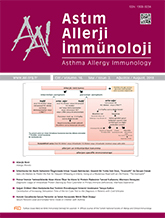


Objective: Periostin is an extracellular matrix protein secreted by airway epithelium and pulmonary fibroblasts. Periostin was shown to play a role in eosinophilic airway inflammation. This study evaluated the serum periostin levels and exhaled nitric oxide (FeNO) in children with asthma.
Materials and Methods: A total of 60 children with intermittent and mild persistent asthma (29 of them were allergic, and 31 of them were nonallergic) and a control group comprising 30 healthy children, ages between 7 and 17 years, were included in the study. Demographic and clinical data of the patients were recorded. The levels of FeNO and serum periostin were measured.
Results: The serum periostin level was significantly correlated with age (59.08±12.79 ng/dL in 6–12 years and 46.18 ± 11.64 ng/dL in 13–18 years, p<0.001). No statistically significant difference was detected between the children with allergic and nonallergic asthma. The FeNO values were not different in the patient and the control groups. When the correlation between NO and periostin values of the only allergic patients was considered, no statistically significant difference was found (r = 0.327, p=0.077). Also, the serum periostin levels were higher in polysensitized children compared with only pollen sensitivity, but the `p` value was not at the significance level (58.2±15.1 and 44.65±8.3, p=0.065).
Conclusion: In this study, serum periostin level was evaluated as a biomarker in children with asthma and it was correlated with age. No significant difference was detected in the serum periostin level of children with intermittent and mild-persistent asthma. Further studies are needed to evaluate serum periostin levels in children with moderate and severe-persistent asthma.